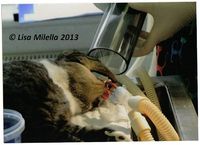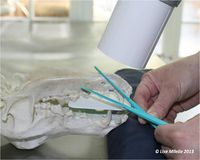Intra-Oral Radiography Techniques - Small Animal
Introduction
General anaesthesia is required for radiography. Ideally clinical examination and recording should precede the radiographic evaluation. It is also useful to clean the teeth before any radiographs are taken. Dental calculus, because it is radiodense, can obscure pathological lesions on a radiograph.
Techniques Used
- Intra-oral techniques should produce radiographs without superimposition of the contralateral side which occurs if an extraoral technique is used.
- Use the correct size film to allow for the best possible positioning.
- Position the film inside the mouth as close to and as exactly parallel to the structures to be radiographed as possible without bending the film. This minimizes the risk of distortion.
- Use paper towel, foam or cotton-wool behind the film to wedge it and maintain it in position.
1. Parallel Technique
The parallel technique is used whenever it is technically possible to place the film parallel to the axis of the tooth roots. In dogs and cats, this applies to the distal mandibular teeth. The film cannot be placed parallel to the teeth in the rostral mandibular premolar region due to the mandibular symphysis and angle of the roots relative to the oral surfaces. This is also the case for the maxillary teeth.
- The film is placed parallel to the tooth.
- The x-ray beam is positioned perpendicular to the film and subject.
- The animal is placed in lateral recumbency with the side to be radiographed uppermost. The intra-oral film is placed lingual to the premolar or molar with the dimple facing towards the teeth. The film needs to gently be pushed ventrally to get the lower edge of the film as close to the ventral border of the mandible as possible.
2. Bisecting Angle Technique
When radiographing teeth other than the mandibular premolars and molars it is not anatomically possible to position the film parallel to the tooth root. The bisecting angle technique uses a principle of geometry (the two sides of an isosceles triangle are equal in length) to prevent image elongation or foreshortening.
- The film should be placed intra-orally as close to the tooth as possible. (Usually this involves placing the cusp tip at the extreme outside (aboral) edge of the film, or even off the film if it is not important to include the crown in the radiograph. This leaves the largest possible surface area of the film available for the roots).
- The film should not be bent, because any curvature of the film will cause distortion of the image.
- The x-ray beam (tube-head) is positioned perpendicular (at a right angle) to an imaginary line that bisects the angle formed between the film and the roots of the teeth being radiographed.
N.B. If the x-ray beam was directed perpendicular to the film then the image would be foreshortened. If the x-ray beam was directed perpendicular to the long axis of the tooth, the image would be elongated.
Full-mouth radiographs describe a series of films where each tooth of the dentition is accurately depicted in at least one view. It is often recommended that all adult cats have full-mouth radiographs taken as part of the oral and dental examination. Odontoclastic resorptive lesions are common in cats and clinical examination without radiography will only detect end-stage lesions.
- Cats - it is necessary to take a minimum of eight views, but 10 views are recommended, to ensure that all teeth are properly visualized.
- Dogs - full-mouth radiographs are encouraged, especially at first examination. If this is not possible then radiographs should be taken where indicated based on the findings during the clinical examination.
Recommended Views
Incisor view in the upper jaw - The film is placed with the incisor cusp tips along the short side of the film that has the dimple. The tube is positioned perpendicular to the film when viewed from the front and to bisect the angle when viewed from the side. Large-breed dogs may require a separate radiograph for the third incisor teeth, with the tube-head angled slightly more laterally when viewed from the front.
Left and right view for each of the canines of the upper jaw - Size 4 (occlusal) film in dogs is helpful to avoid missing the root apex. Size 2 film can be used in cats and small dogs. The film is placed horizontally in the mouth with the canine cusp tip on the outside, rostral corner of the film. The tube is positioned to bisect the angle when viewed from the side, and angled laterally from a dorsovental (DV) position when viewed from the front. This projects the root tip to the opposite corner of the film from the cusp tip.
Left and right maxillary premolar and molar views - The first to third premolars are often included on one image, and a separate radiograph is made of the fourth premolar. On small dogs, it may be possible to include all the premolars on a single radiograph. On cats the premolars and molar can be included in one image. The tube is positioned to bisect the angle when viewed from the front and perpendicular to the film and alveolar ridge when viewed from the top or side. Tube-shift can be performed to separate superimposed structures on the image. The alveolar arch curves medially behind the premolars in most dogs. The tube is positioned to bisect the angle when viewed from rostrolateral (from the mesial contact surface of the tooth), and perpendicular to the film, the buccal surface of the molars and alveolar ridge when viewed from the top.
Mandibular incisor and canine view - One radiograph can include all the incisor teeth in dogs and all incisor and mandibular canine teeth in cats. The film is placed with the incisor cusp tips along the short side of the film. The tube is positioned perpendicular to the film when viewed from the front and to bisect the angle when viewed from the side. For larger dogs one radiograph can include the apices of both canine teeth. The positioning is similar to that for the mandibular incisors but angled slightly more ventrodorsally. The tube is positioned to bisect the angle when viewed from the side. For dedicated radiographs of one canine tooth (for example, during endodontic treatment) and to prevent superimposition of the first premolar tooth, the tube can be angled slightly laterally rather than perpendicular when viewed from the front.
Lateral canine and rostral (mesial) mandibular premolars - The mandibular canine and rostral premolar teeth are adjacent to the symphysis, requiring the film to be placed along the floor of the mouth, on top of the tongue to avoid the frenulum preventing the film being placed correctly. The tube is positioned to bisect the angle when viewed from the front, and perpendicular to the film when viewed from the side or top.
Lateral view of the distal premolars and molar teeth of the mandible - This is the one region in which parallel technique can routinely be used. The film is placed into the space between the tongue and the lingual surface of the mandible, positioned apically so the cusp tip is level with the top of the film. The tube is positioned perpendicular to the plane of the tooth roots and to the film.
Tube Shift
Structures that are superimposed can be separated on the radiograph by shifting the tube-head in the third axis while maintaining the bisecting angle in the plane that includes the axis of the root and the edge (plane) of the film. For example, when making a radiograph of the premolar region, the tube-shift redirects the x-ray beam to a mesial-to-distal or distal-to-mesial direction while maintaining the bisecting angle position when viewed from the front of the patient (transverse plane). Shifting the tube mesially (mesiobuccal to distopalatal beam) moves objects that are closer to the tube-head distally on the radiograph image and objects that are closer to the film mesially.
Conversely, when the tube-head is shifted distally (distobuccal to mesiopalatal beam), objects that are closer to the tube-head will move mesially on the radiograph, while objects closer to the film will move distally on the radiograph. In other words, objects on the radiograph that move the same direction that the tube was shifted are on the palatal/lingual side, while objects that move the opposite direction from which the tube was shifted are on the buccal/labial side. A helpful acronym to remember this relationship is the SLOB rule, which stands for Same Lingual Opposite Buccal.
| Intra-Oral Radiography Techniques - Small Animal Learning Resources | |
|---|---|
To reach the Vetstream content, please select |
Canis, Felis, Lapis or Equis |
| This article was written by Lisa Milella BVSc DipEVDC MRCVS. Date reviewed: 1 October 2014 |
| Endorsed by WALTHAM®, a leading authority in companion animal nutrition and wellbeing for over 50 years and the science institute for Mars Petcare. |
Error in widget FBRecommend: unable to write file /var/www/wikivet.net/extensions/Widgets/compiled_templates/wrt6933e1b758f5f5_76235689 Error in widget google+: unable to write file /var/www/wikivet.net/extensions/Widgets/compiled_templates/wrt6933e1b76adef5_15173073 Error in widget TwitterTweet: unable to write file /var/www/wikivet.net/extensions/Widgets/compiled_templates/wrt6933e1b774b6b9_30215528
|
| WikiVet® Introduction - Help WikiVet - Report a Problem |

